| |
Skeletal Anatomy of a Tyrannosaurid
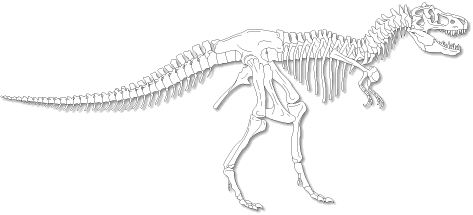
 The vertebrae actually extend
from the base of the skull to the tip of the tail. Yet each vertebra had
a specific purpose. From the base of the skull to the top of the rib cage,
the neck vertebrae supported the side-to-side and up-and-down motion of
the dinosaur's head. The spines on the top of the vertebrae added support
and strength for muscles that controlled the dinosaurs head movement. Chevron
shaped bones on the bottom of the tail vertebrae gave added strength for
muscle attachments, as well as protection for vital blood vessels. The
large saurischians, such as carnosaurs, required extra support for their
enormous heads -- that's the reason for the extra thick neck bones. The
spinal cord passed through the neck vertebrae and on to the rest of the
body. Rough places on the bone help paleontologists determine where muscles
were attached. The vertebrae actually extend
from the base of the skull to the tip of the tail. Yet each vertebra had
a specific purpose. From the base of the skull to the top of the rib cage,
the neck vertebrae supported the side-to-side and up-and-down motion of
the dinosaur's head. The spines on the top of the vertebrae added support
and strength for muscles that controlled the dinosaurs head movement. Chevron
shaped bones on the bottom of the tail vertebrae gave added strength for
muscle attachments, as well as protection for vital blood vessels. The
large saurischians, such as carnosaurs, required extra support for their
enormous heads -- that's the reason for the extra thick neck bones. The
spinal cord passed through the neck vertebrae and on to the rest of the
body. Rough places on the bone help paleontologists determine where muscles
were attached.
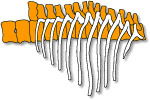 The rib vertebrae actually
extended from the base of the neck to the dinosaur's hip. The rib vertebrae
are also referred to as the backbone. The spines of the rib vertebrae are
higher and stronger to allow for greater muscle attachment, making the
back strong in the face of the enormous weight of the dinosaur's body mass.
The spinal cord continued through the rib vertebrae from the neck vertebrae
and on to the tail vertebrae. The ribs (shown in gray) protected the dinosaur's
vital organs, heart, lungs, and digestive track. The rib vertebrae actually
extended from the base of the neck to the dinosaur's hip. The rib vertebrae
are also referred to as the backbone. The spines of the rib vertebrae are
higher and stronger to allow for greater muscle attachment, making the
back strong in the face of the enormous weight of the dinosaur's body mass.
The spinal cord continued through the rib vertebrae from the neck vertebrae
and on to the tail vertebrae. The ribs (shown in gray) protected the dinosaur's
vital organs, heart, lungs, and digestive track.
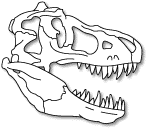 The carnivorous saurischian dinosaurs
had powerful jaws and cavernous skulls. Tyrannosaurus, for example, had
the largest head of all carnosaurs and and its jaw was equipped with sharp,
serrated teeth. Its large mouth, typical of carnosaurs, was hinged so that
the gaping mouth could scoop out large chunks of its prey. The carnivorous saurischian dinosaurs
had powerful jaws and cavernous skulls. Tyrannosaurus, for example, had
the largest head of all carnosaurs and and its jaw was equipped with sharp,
serrated teeth. Its large mouth, typical of carnosaurs, was hinged so that
the gaping mouth could scoop out large chunks of its prey.
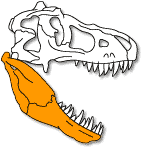 The jaws of saurischian dinosaurs
were capable of opening very wide. In contrast to the powerful jaws of
the carnivorous saurischians, the herbivorous saurischian's jaws were weak;
they only nipped vegetation, then swallowed it to be ground to a soft pulp
by gastroliths. The jaws of saurischian dinosaurs
were capable of opening very wide. In contrast to the powerful jaws of
the carnivorous saurischians, the herbivorous saurischian's jaws were weak;
they only nipped vegetation, then swallowed it to be ground to a soft pulp
by gastroliths.
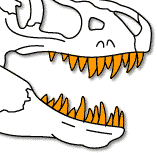 Teeth among dinosaurs differed
according to the kind of food they consumed. For example, meat eaters typically
had sharp pointed teeth. Plant eaters had flat, sometimes spoon-shaped
teeth for tearing foliage from trees and grinding them to pulp. Many ornithischians
had huge numbers of small teeth that were continually replaced, allowing
them to chew vegetation. Teeth among dinosaurs differed
according to the kind of food they consumed. For example, meat eaters typically
had sharp pointed teeth. Plant eaters had flat, sometimes spoon-shaped
teeth for tearing foliage from trees and grinding them to pulp. Many ornithischians
had huge numbers of small teeth that were continually replaced, allowing
them to chew vegetation.
 The scapula is the shoulder
blade. Tyrannosaurus' small but strong arms were connected to the scapula. The scapula is the shoulder
blade. Tyrannosaurus' small but strong arms were connected to the scapula.
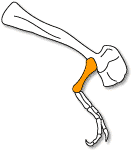 The humerus or upper arm bone
helped to support the forward part of the body in quadrupedal dinosaurs.
It was connected to the shoulder bone or scapula. The humerus or upper arm bone
helped to support the forward part of the body in quadrupedal dinosaurs.
It was connected to the shoulder bone or scapula.
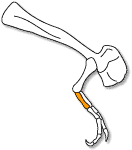 The ulna extended from the bottom
of the humerus to the wrist. It is next to the radius in the forearm The ulna extended from the bottom
of the humerus to the wrist. It is next to the radius in the forearm
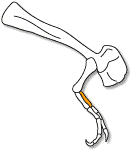 The radius in the "forearm."
The radius extended from the bottom of the humerus to the wrist. The radius in the "forearm."
The radius extended from the bottom of the humerus to the wrist.
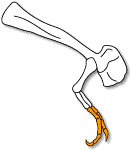 The grasping members at the
end of the arms of bipedal dinosaurs are called hands, rather than paws.
The hand pictured is from Tyrannosaurus, whose very small two-fingered
hands puzzle scientists. The grasping members at the
end of the arms of bipedal dinosaurs are called hands, rather than paws.
The hand pictured is from Tyrannosaurus, whose very small two-fingered
hands puzzle scientists.
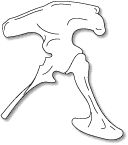 The hip bones served as the pivot
point for leg bones and helped to provide stability. The hip bones served as the pivot
point for leg bones and helped to provide stability.
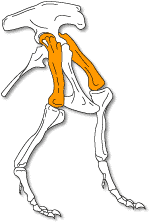 The femur helped support the dinosaur's The femur helped support the dinosaur's
 massive body. massive body.
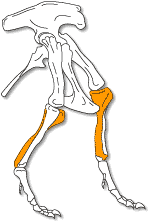 The tibia (the shin bone) helped the dinosaur support its The tibia (the shin bone) helped the dinosaur support its
 massive body. massive body.
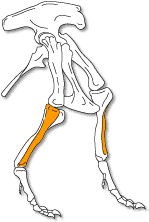 The fibula (a leg bone) helped support the dinosaur's The fibula (a leg bone) helped support the dinosaur's
 massive body. massive body.
 Dinosaur feet were composed
of many bones. All carnosaurs had talons (claws) that were very sharp and
pointed. In contrast, the feet of a sauropod had large pads on the bottom.
For example, a brachiosaurid's feet resemble those of an elephant which
are especially adapted for supporting great weights. Dinosaur feet were composed
of many bones. All carnosaurs had talons (claws) that were very sharp and
pointed. In contrast, the feet of a sauropod had large pads on the bottom.
For example, a brachiosaurid's feet resemble those of an elephant which
are especially adapted for supporting great weights.

Dinosaur tails were as varied as the dinosaurs. Their tails consisted
of as many as 100 vertebrae or as few as 50. The purpose of dinosaurs'
tails is generally thought to be for balance. They provided stability for
fast-moving theropods and weapons of defense for stegosaurids, ankylosaurids,
and possibly even sauropods. |
| 
|
Jurassic Art
Database Home
Order Software



|
